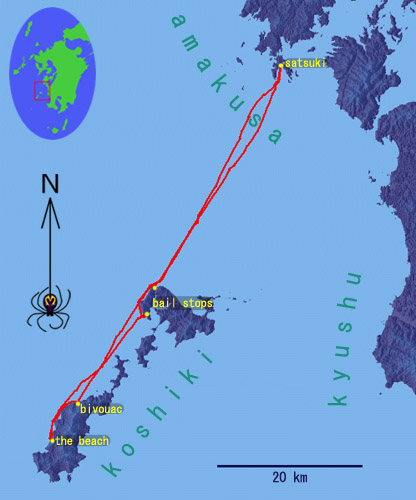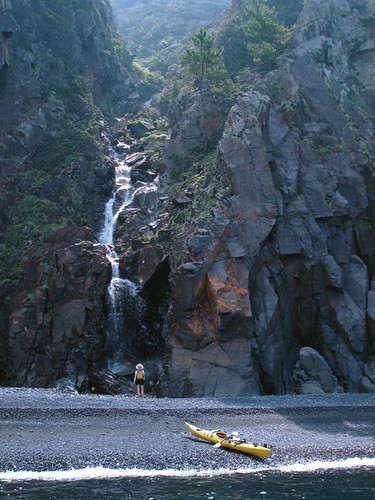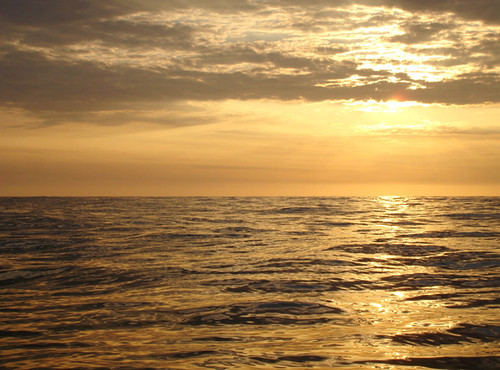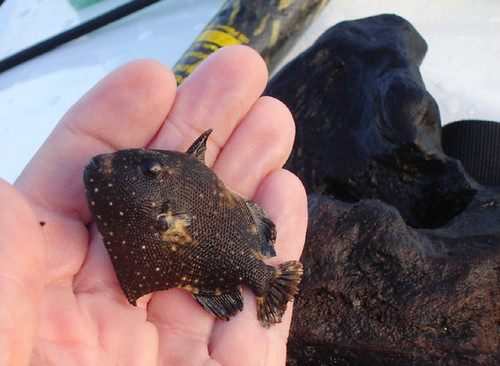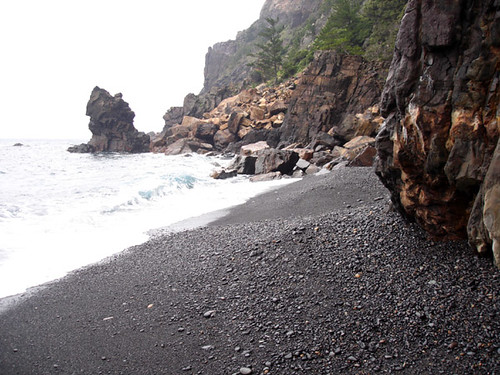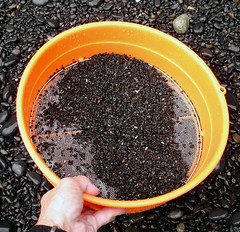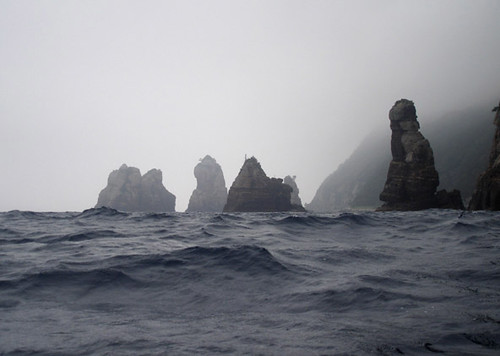Black Sand Part II: the Aquarium
Please allow me to introduce my new aquarium, furnished with the Koshiki sand that I brought in at such bodily peril, and several of its 15 or so kinds of inhabitants.
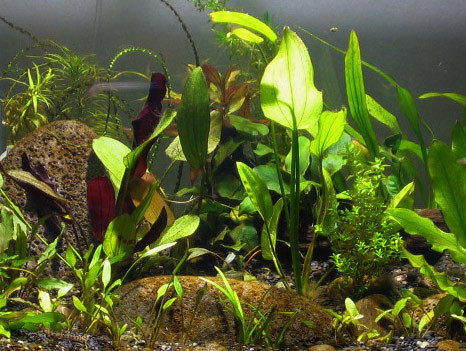
This is the freshly set up tank as of late July this year. I bought all kinds of plants and threw them together more or less haphazardly. The powerful light and the different fertilizer schemes I was experimenting with contributed to a hideous algae breakout not long after this picture was taken. With various forms of chemical, physical, and biological warfare, the algae problems were finally brought under control two or three months later. Some of the biological warriors, the so-called algae control crew, will be introduced shortly.
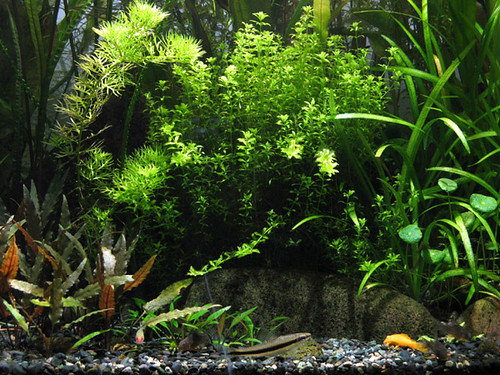
More or less he same area of the tank, as of December 22nd. Plants require frequent trimming, and algae is under nearly total control. The algae-control crew now need regular supplements of parboiled spinach, and the tank is fairly pleasant and interesting to look at. Here, various fish vie for fragments of food tablets scattered over the substrate. I've nearly finished learning about establishing and balancing plant growth; next will come the even more difficult task of achieving that delicate balance of gardening skill and artistic arangement that makes the successful planted aquarium so irresistible to look at.
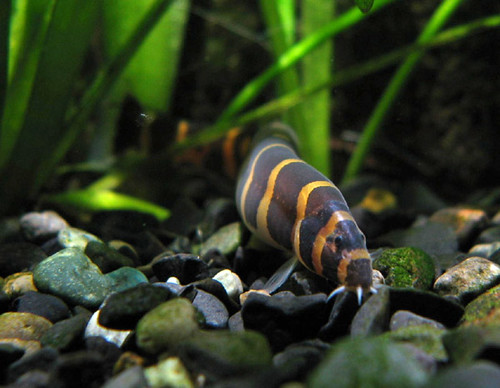
A fish that definitely enjoys the Koshiki sand is the Kuhli Loach (Pangio kuhlii). These small, eel-like fish used to be one of my favorites in my fish-keeping days of old, having adapted especially well to my estwhile small tank. During the day, they would be nowhere to be seen, but at night, their crazy wigglings seen from my bed in the half-darkness of my room would lull me to sleep. In my current tank, they are active day and night, and very opportunistic when it comes to foraging for food. For a long snaky fish, this critter is actually getting pretty fat.
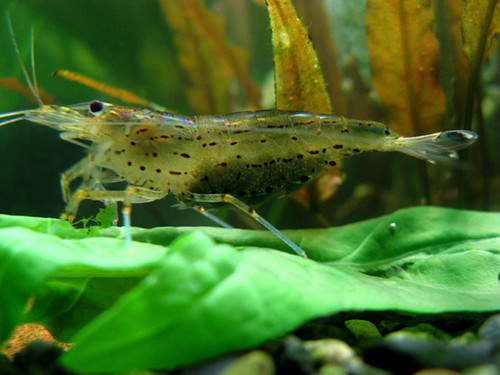
The shrimp Caridina japonica is one of the most interesting inhabitants of the tank. There are about 23 of these, constantly crawling and swimming about (especially at night). I originally bought a batch at the store, after reading about their near-miraculous algae-eating performance on the Net, mostly from reports by American aquarists: this native shrimp is indeed in high demand around the world. Subsequently, during a trip to a nearby mountain stream, I discovered it teeming with the same little creatures. I was delighted, and caught around a dozen more, introducing them to the tank. Since then, the larger females like this one (seen here feeding on parboiled spinach) can be seen carrying batches of eggs. The shrimp has a fascinating life cycle: afer a rather long incubation period during which the eggs remain attached to the mother shimp and are frequently fanned by her pleopods (stomach-legs), the tiny mosquito-larva-like young emerge and are subsequently washed into the sea by the stream where they were born. Spending a few weeks in salt water feeding on plankton, they finally metamorphose into tiny shrimp which, finding a river mouth, migrate up as far as its highest reaches. They even crawl out of the water and over the rocks in places where there are waterfalls or other obstacles. This reproductive cycle as well as other facts about the shrimp are, from what I gather reading the Net, generally misunderstood by today’s aquarists. For one thing, they are misled by the common Japanese name of the species, which is the Yamato Swamp Shrimp. But it lives in clear mountain streams, not swamps! Anyway, it can be bred in captivity by changing the salt content of the water appropriately, something that I will attempt to do soon (in another tank of course), to set the record strait and also because I am simply fascinated. As it is, the eggs do hatch in the main tank, but the little larvae are soon eaten by various fish.
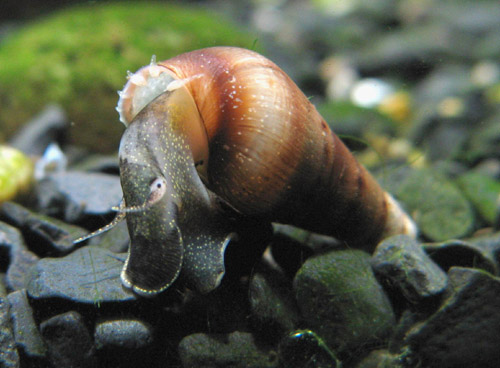
This is the Malaysian Trumpet Snail, Melanoides tuberculata. These small (1.5cm) nocturnal snails are much praised on the net by American aquarists, because during the day they burrow in the substrate, keeping it well tilled. I got all excited when I spotted some at the local store, but the owner looked at me funny when I wanted to buy them: in Japan their benefits are evidently not well understood and they only make their way into store tanks by accident. Indeed, the three or four I was subsequently given free of charge multiplied exponentially within a few months.
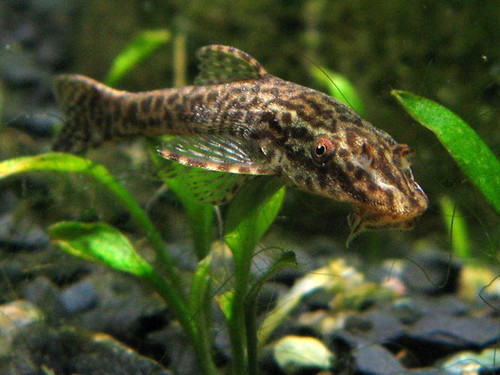
This Otocinclus spp. (?) is one of the algae-control crew. These fish eat algae off plant leaves, and, unlike the other crew members, nothing else. I haven’t even seen them munching on the spinach. Fortunately they’re small enough (maybe 3cm) that they can always find a morsel growing somewhere in the tank.
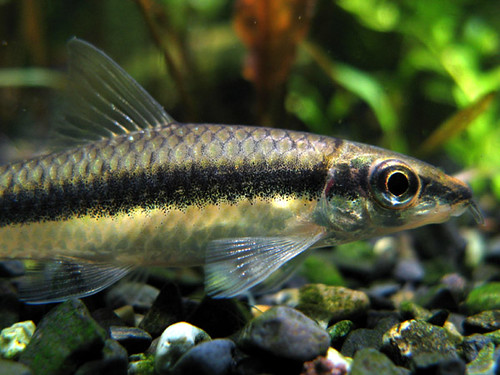
I am not exactly sure why, but the so-called Siamese Algae Eater (Crossocheilus siamensis) is one of my favorite fish. The rightful chief of the algae-control crew, he is known to devour even algae which all other creatures find unappetizing, so that along with the Caridina shrimp he can be seen in almost all planted aquaria. At about 10cm in length, this minnow-like fish is the largest creature in my tank (I’ve chosen to stock exclusively small fish). It's not exactly colorful, but the reflecting silver belly, jet black side stripe, and dorsal scales enhanced with a dark-brown pattern, give this fish a very pleasing textured look. Heavier than water, he rests on the substrate, or more comfortably on a large plant leaf when not active.
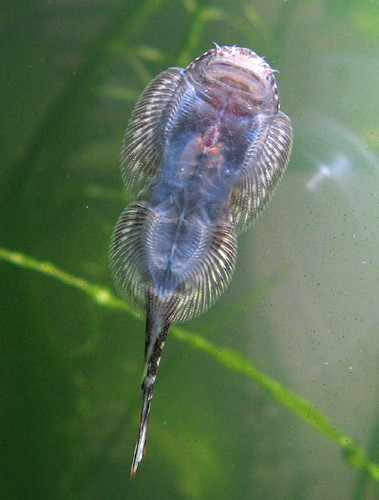
The underside of Gastromyzon or Beaufortia spp., aka Hillstream Loach. I made a bit of a mistake with this fascinating fish, thinking it a type of pleco-like suckermouth. What I did not find out until later was that these fish live in fast-flowing streams in the mountains of their native Borneo where they cling to rocks – hence their suction-cup fins as well as mouth. Anyway, to be truly happy they need a special stream setup, and a mostly stagnant aquarium is not really suitable for them. Nevertheless for a few months this character could be seen eating algae off the glass or sitting by the filter outlet where there was at least a little current. Then he disappeared – I am not sure where to, but perhaps he died, and the shrimp made a quick meal of what was left of him.

This is Corydoras sterbai, one of the most sought-after of the numerous similar species of corydoras catfish from the Amazon basin. A loose shoal of five of these fish scours the substrate in my tank, looking for morsels. Very shy at first, they are gradually getting used to their new digs and lately can often be seen out in the relatively open front area of the tank.
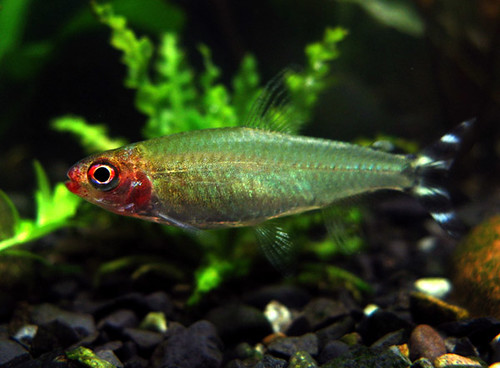
The Rummy-nose Tetra (Hemigrammus bleheri). I keep a small school of eight of these delicately colorful fish. They are lively swimmers by the day, but by night their color fades completely and they sleep wedged in the plants or on the substrate so that at first I was alarmed some had died! When they are happy their whole head turns a rich crimson red, and this is also a good indicator of water quality and general living conditions in the aquarium. However at such a time it’s impossible (with my camera anyway) to get a clear picture of them, so here is one that is just waking up.
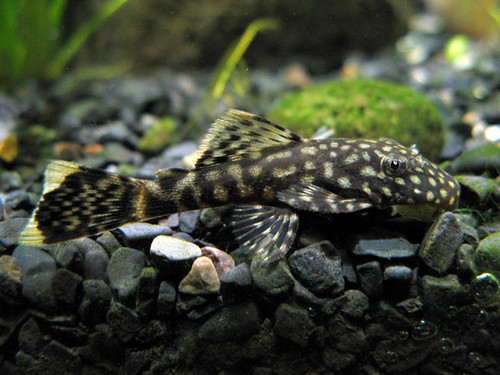
Bushy Nose Pleco (Ancistrus spp.) This fish is also a part of the algae control corps. He’s fun to watch, darting from driftwood to glass to plant leaves all of which he rasps clean of algae with his suction-cup mouth. Males of this genus grow bristles on their head, but this one is either still very young or a female, as there is no sign of bristles. Or perhaps it's not an Ancistrus at all? These pleco-like catfish are notoriously difficult to identify, owing to a plethora of similar-looking species, which may have been further hybridized by breeders.
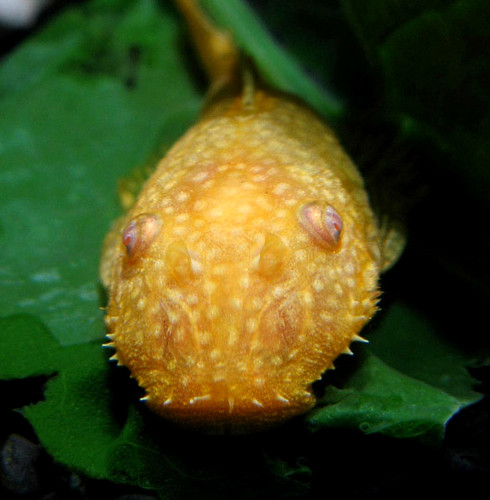
The one more Ancistrus that lives in the tank is an albino and he’s begun to grow some bristles. Normally, 'serious' aquarists shun albinos and such, claiming they are 'unnatural' (albinos occur in nature but are soon spotted and eaten by predators). But when I saw how cute this guy was, I couldn't resist. At first he would not come out of his driftwood cave by light, but lately he can be lured out with some tasty soft spinach.

This is the freshly set up tank as of late July this year. I bought all kinds of plants and threw them together more or less haphazardly. The powerful light and the different fertilizer schemes I was experimenting with contributed to a hideous algae breakout not long after this picture was taken. With various forms of chemical, physical, and biological warfare, the algae problems were finally brought under control two or three months later. Some of the biological warriors, the so-called algae control crew, will be introduced shortly.

More or less he same area of the tank, as of December 22nd. Plants require frequent trimming, and algae is under nearly total control. The algae-control crew now need regular supplements of parboiled spinach, and the tank is fairly pleasant and interesting to look at. Here, various fish vie for fragments of food tablets scattered over the substrate. I've nearly finished learning about establishing and balancing plant growth; next will come the even more difficult task of achieving that delicate balance of gardening skill and artistic arangement that makes the successful planted aquarium so irresistible to look at.

A fish that definitely enjoys the Koshiki sand is the Kuhli Loach (Pangio kuhlii). These small, eel-like fish used to be one of my favorites in my fish-keeping days of old, having adapted especially well to my estwhile small tank. During the day, they would be nowhere to be seen, but at night, their crazy wigglings seen from my bed in the half-darkness of my room would lull me to sleep. In my current tank, they are active day and night, and very opportunistic when it comes to foraging for food. For a long snaky fish, this critter is actually getting pretty fat.

The shrimp Caridina japonica is one of the most interesting inhabitants of the tank. There are about 23 of these, constantly crawling and swimming about (especially at night). I originally bought a batch at the store, after reading about their near-miraculous algae-eating performance on the Net, mostly from reports by American aquarists: this native shrimp is indeed in high demand around the world. Subsequently, during a trip to a nearby mountain stream, I discovered it teeming with the same little creatures. I was delighted, and caught around a dozen more, introducing them to the tank. Since then, the larger females like this one (seen here feeding on parboiled spinach) can be seen carrying batches of eggs. The shrimp has a fascinating life cycle: afer a rather long incubation period during which the eggs remain attached to the mother shimp and are frequently fanned by her pleopods (stomach-legs), the tiny mosquito-larva-like young emerge and are subsequently washed into the sea by the stream where they were born. Spending a few weeks in salt water feeding on plankton, they finally metamorphose into tiny shrimp which, finding a river mouth, migrate up as far as its highest reaches. They even crawl out of the water and over the rocks in places where there are waterfalls or other obstacles. This reproductive cycle as well as other facts about the shrimp are, from what I gather reading the Net, generally misunderstood by today’s aquarists. For one thing, they are misled by the common Japanese name of the species, which is the Yamato Swamp Shrimp. But it lives in clear mountain streams, not swamps! Anyway, it can be bred in captivity by changing the salt content of the water appropriately, something that I will attempt to do soon (in another tank of course), to set the record strait and also because I am simply fascinated. As it is, the eggs do hatch in the main tank, but the little larvae are soon eaten by various fish.

This is the Malaysian Trumpet Snail, Melanoides tuberculata. These small (1.5cm) nocturnal snails are much praised on the net by American aquarists, because during the day they burrow in the substrate, keeping it well tilled. I got all excited when I spotted some at the local store, but the owner looked at me funny when I wanted to buy them: in Japan their benefits are evidently not well understood and they only make their way into store tanks by accident. Indeed, the three or four I was subsequently given free of charge multiplied exponentially within a few months.

This Otocinclus spp. (?) is one of the algae-control crew. These fish eat algae off plant leaves, and, unlike the other crew members, nothing else. I haven’t even seen them munching on the spinach. Fortunately they’re small enough (maybe 3cm) that they can always find a morsel growing somewhere in the tank.

I am not exactly sure why, but the so-called Siamese Algae Eater (Crossocheilus siamensis) is one of my favorite fish. The rightful chief of the algae-control crew, he is known to devour even algae which all other creatures find unappetizing, so that along with the Caridina shrimp he can be seen in almost all planted aquaria. At about 10cm in length, this minnow-like fish is the largest creature in my tank (I’ve chosen to stock exclusively small fish). It's not exactly colorful, but the reflecting silver belly, jet black side stripe, and dorsal scales enhanced with a dark-brown pattern, give this fish a very pleasing textured look. Heavier than water, he rests on the substrate, or more comfortably on a large plant leaf when not active.

The underside of Gastromyzon or Beaufortia spp., aka Hillstream Loach. I made a bit of a mistake with this fascinating fish, thinking it a type of pleco-like suckermouth. What I did not find out until later was that these fish live in fast-flowing streams in the mountains of their native Borneo where they cling to rocks – hence their suction-cup fins as well as mouth. Anyway, to be truly happy they need a special stream setup, and a mostly stagnant aquarium is not really suitable for them. Nevertheless for a few months this character could be seen eating algae off the glass or sitting by the filter outlet where there was at least a little current. Then he disappeared – I am not sure where to, but perhaps he died, and the shrimp made a quick meal of what was left of him.

This is Corydoras sterbai, one of the most sought-after of the numerous similar species of corydoras catfish from the Amazon basin. A loose shoal of five of these fish scours the substrate in my tank, looking for morsels. Very shy at first, they are gradually getting used to their new digs and lately can often be seen out in the relatively open front area of the tank.

The Rummy-nose Tetra (Hemigrammus bleheri). I keep a small school of eight of these delicately colorful fish. They are lively swimmers by the day, but by night their color fades completely and they sleep wedged in the plants or on the substrate so that at first I was alarmed some had died! When they are happy their whole head turns a rich crimson red, and this is also a good indicator of water quality and general living conditions in the aquarium. However at such a time it’s impossible (with my camera anyway) to get a clear picture of them, so here is one that is just waking up.

Bushy Nose Pleco (Ancistrus spp.) This fish is also a part of the algae control corps. He’s fun to watch, darting from driftwood to glass to plant leaves all of which he rasps clean of algae with his suction-cup mouth. Males of this genus grow bristles on their head, but this one is either still very young or a female, as there is no sign of bristles. Or perhaps it's not an Ancistrus at all? These pleco-like catfish are notoriously difficult to identify, owing to a plethora of similar-looking species, which may have been further hybridized by breeders.

The one more Ancistrus that lives in the tank is an albino and he’s begun to grow some bristles. Normally, 'serious' aquarists shun albinos and such, claiming they are 'unnatural' (albinos occur in nature but are soon spotted and eaten by predators). But when I saw how cute this guy was, I couldn't resist. At first he would not come out of his driftwood cave by light, but lately he can be lured out with some tasty soft spinach.
Labels: aquarium 水槽
